Chevrolet Captiva Service & Repair Manual: Brake Pads R&R
| Warning: Avoid taking the following
actions when you service wheel brake parts: Do not grind brake linings,
do not sand brake linings and do not clean wheel brake parts with a dry
brush or with compressed air. |
| Warning: Some models or aftermarket
brake parts may contain asbestos fibers which can become airborne in dust.
Breathing dust with asbestos fibers may cause serious bodily harm. Use a
water-dampened cloth in order to remove any dust on brake parts. Equipment
is available commercially in order to perform this washing function. These
wet methods prevent fibers from becoming airborne. |
Front
Removal
| Caution: Support the brake
caliper with heavy mechanic wire, or equivalent, whenever it is separated
from its mount and the hydraulic flexible brake hose is still connected.
Failure to support the caliper in this manner will cause the flexible brake
hose to bear the weight of the caliper, which may cause damage to the brake
hose and in turn may cause a brake fluid leak. |
| Always replace disc brake pads
in axle sets. |
| DO NOT use any air tools to remove
or install the guide pin bolts. Use hand tools ONLY. |
| Install an open end wrench to
hold the caliper guide pin in line with the brake caliper while removing
or installing the caliper guide pin bolt. DO NOT allow the open end wrench
to come in contact with the brake caliper. Allowing the open end wrench
to come in contact with the brake caliper will cause a pulsation when the
brakes are applied. |
| 1. |
Inspect the fluid level in the brake
master cylinder reservoir. |
| 2. |
If the brake fluid level is midway
between the maximum-full point and the minimum allowable level,
no brake fluid needs to be removed before proceeding. |
| 3. |
If the brake fluid level is higher
than midway between the maximum-full point and the minimum allowable
level, remove brake fluid to the midway point before proceeding. |
| 4. |
Raise and support the vehicle. |
| 5. |
Remove the tire and wheel assembly. |
| 6. |
Remove the lower brake caliper guide
pin bolt (1). Hold the brake caliper guide pin stationary when removing
the guide pin bolt, Fig. 1. |
| 7. |
Pivot the brake caliper (1) upward
and support with heavy mechanics wire or equivalent, Fig.
2. |
| 8. |
Place a block of wood or an old brake
pad against the brake caliper pistons. |
| 9. |
Using a brake pad spreader tool or
equivalent, fully seat the caliper pistons in the caliper bores. |
| 10. |
Remove the inner brake pad (1) and
the outer brake pad (2). Note the location of the brake pad wear
sensor for correct installation, Fig. 3. |
| 11. |
Remove the upper and lower brake pad
shims (1), Fig. 4. |
| 12. |
If installing new brake pads, discard
the shims. |
|
Installation
| DO NOT use any air tools to remove
or install the guide pin bolts. Use hand tools ONLY. |
| Install an open end wrench to
hold the caliper guide pin in line with the brake caliper while removing
or installing the caliper guide pin bolt. DO NOT allow the open end wrench
to come in contact with the brake caliper. Allowing the open end wrench
to come in contact with the brake caliper will cause a pulsation when the
brakes are applied. |
| 1. |
Install the upper and lower brake pad
shims. If installing new brake pads, install new shims. |
| 2. |
Install the inner brake pad and the
outer brake pad. Note the location of the brake pad wear sensor
for correct installation. |
| 3. |
Pivot the brake caliper into position
and install the lower brake caliper guide pin bolt. Hold the brake
caliper guide pin stationary when installing the guide pin bolt.
Torque the bolt to 20 ft. lbs. |
| 4. |
Install the tire and wheel assembly. |
| 6. |
With the engine OFF, gradually apply
the brake pedal to approximately 2/3 of its travel distance. |
| 7. |
Slowly release the brake pedal. |
| 8. |
Wait 15 seconds, then repeat steps
6-7 until a firm brake pedal is obtained. This will properly seat
the brake caliper pistons and brake pads. |
| 9. |
Fill the master cylinder reservoir
to the proper level. |
| 10. |
Burnish the pads and rotors. |
|
Rear
Removal
| Caution: Support the brake
caliper with heavy mechanic wire, or equivalent, whenever it is separated
from its mount and the hydraulic flexible brake hose is still connected.
Failure to support the caliper in this manner will cause the flexible brake
hose to bear the weight of the caliper, which may cause damage to the brake
hose and in turn may cause a brake fluid leak. |
| Always replace disc brake pads
in axle sets. |
| DO NOT use any air tools to remove
or install the guide pin bolts. Use hand tools ONLY. |
| Install an open end wrench to
hold the caliper guide pin in line with the brake caliper while removing
or installing the caliper guide pin bolt. DO NOT allow the open end wrench
to come in contact with the brake caliper. Allowing the open end wrench
to come in contact with the brake caliper will cause a pulsation when the
brakes are applied. |
| 1. |
Inspect the fluid level in the brake
master cylinder reservoir. |
| 2. |
If the brake fluid level is midway
between the maximum-full point and the minimum allowable level,
no brake fluid needs to be removed before proceeding. |
| 3. |
If the brake fluid level is higher
than midway between the maximum-full point and the minimum allowable
level, remove brake fluid to the midway point before proceeding. |
| 4. |
Raise and support the vehicle. |
| 5. |
Remove the tire and wheel assembly. |
| 6. |
Remove the lower brake caliper guide
pin bolt (1). Hold the brake caliper guide pin stationary when removing
the guide pin bolt, Fig. 5. |
| 7. |
Pivot the brake caliper (1) upward
and support with heavy mechanics wire or equivalent, Fig.
6. |
| 8. |
Place a block of wood or an old brake
pad against the brake caliper pistons. |
| 9. |
Using a brake pad spreader tool or
equivalent, fully seat the caliper piston in the caliper bore. |
| 10. |
Remove the outer brake pad (1) and
the inner brake pad (2). Note the location of the brake pad wear
sensor for correct installation, Fig. 7. |
| 11. |
Remove the upper and lower brake pad
shims (1), Fig. 8. |
| 12. |
If installing new brake pads, discard
the shims. |
|
Installation
| DO NOT use any air tools to remove
or install the guide pin bolts. Use hand tools ONLY. |
| Install an open end wrench to
hold the caliper guide pin in line with the brake caliper while removing
or installing the caliper guide pin bolt. DO NOT allow the open end wrench
to come in contact with the brake caliper. Allowing the open end wrench
to come in contact with the brake caliper will cause a pulsation when the
brakes are applied. |
| 1. |
Install the upper and lower brake pad
shims. If installing new brake pads, install new shims. |
| 2. |
Install the outer brake pad and the
inner brake pad. Note the location of the brake pad wear sensor
for correct installation. |
| 3. |
Pivot the brake caliper into position
and install the lower brake caliper guide pin bolt. Hold the brake
caliper guide pin stationary when installing the guide pin bolt.
Torque the bolt to 20 ft. lbs. |
| 4. |
Install the tire and wheel assembly. |
| 6. |
With the engine OFF, gradually apply
the brake pedal to approximately 2/3 of its travel distance. |
| 7. |
Slowly release the brake pedal. |
| 8. |
Wait 15 seconds, then repeat steps
6-7 until a firm brake pedal is obtained. This will properly seat
the brake caliper pistons and brake pads. |
| 9. |
Fill the master cylinder reservoir
to the proper level. |
| 10. |
Burnish the pads and rotors. |
|
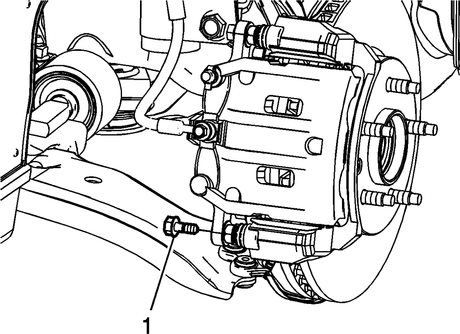
Fig.
1
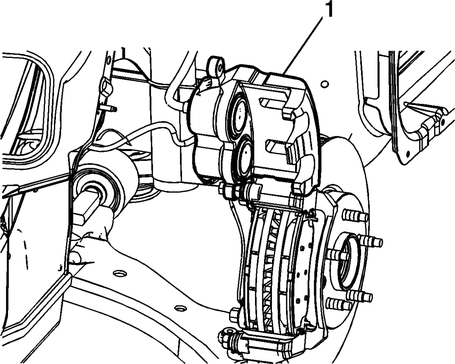
Fig.
2
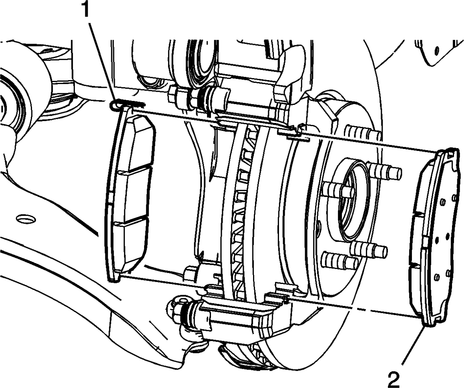
Fig.
3
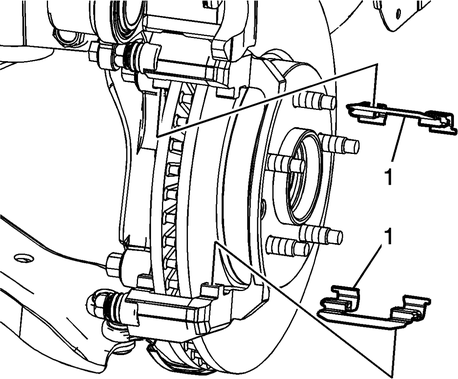
Fig.
4
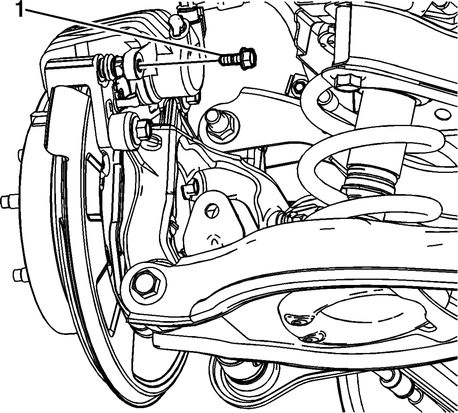
Fig.
5
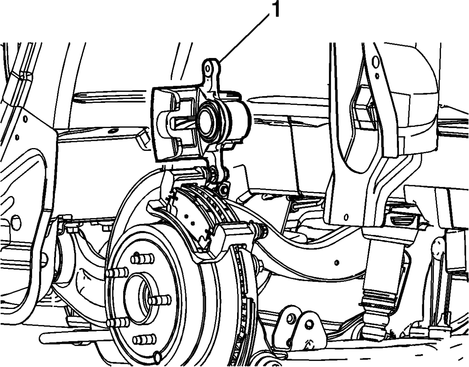
Fig.
6
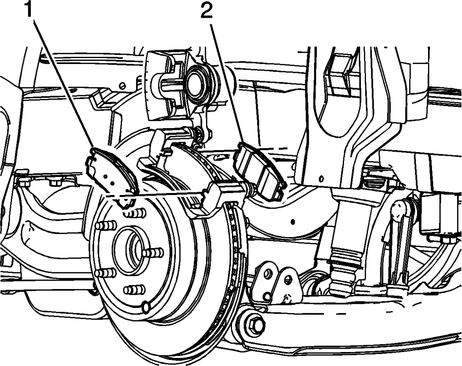
Fig.
7
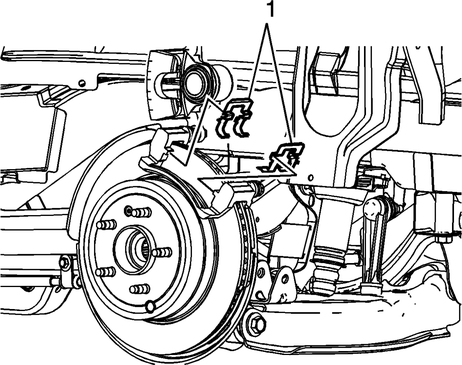
Fig.
8
To install or remove brake pads on a Chevrolet Captiva (Captiva Sport), start by securing the vehicle on a level surface and engaging the parking brake. Ensure the transmission is in park (for automatic) or neutral (for manual) and the ignition is turned off. Use a jack to lift the vehicle and secure it with jack stands for added safety.
For brake pad removal, locate the brake caliper behind the wheel. Remove the caliper bolts using an appropriate wrench or socket, then carefully lift the caliper away from the rotor. Hang the caliper using a wire or hook to prevent strain on the brake hose. Remove the old brake pads from the caliper bracket and inspect them for wear, damage, or uneven wear patterns.
Before installing new brake pads, ensure the caliper piston is compressed fully back into the caliper housing using a C-clamp or brake caliper tool. This step is crucial to make room for the thicker new brake pads. Insert the new brake pads into the caliper bracket, ensuring they are correctly positioned and secure. Slide the caliper back over the pads and rotor, then tighten the caliper bolts to the manufacturer's specifications.
After installing the new brake pads, pump the brake pedal several times to seat the pads against the rotor. Check the brake fluid level in the master cylinder reservoir and adjust if necessary. Finally, repeat the process for the remaining wheels if needed, and test the brakes to ensure proper operation before driving the vehicle.
Removal
1.
Using a suitable tool, remove the brake
fluid from the brake master cylinder reservoir.
2.
Discard the brake fluid into an ap ...
2.4L
A small amount of denatured alcohol
may be used to ease assembly. Do not use soap.
1.
With the engine OFF, apply and release
the brake pedal se ...








 Brake Master Cylinder Reservoir R&R
Brake Master Cylinder Reservoir R&R Brake Power Booster Unit Check Valve R&R
Brake Power Booster Unit Check Valve R&R